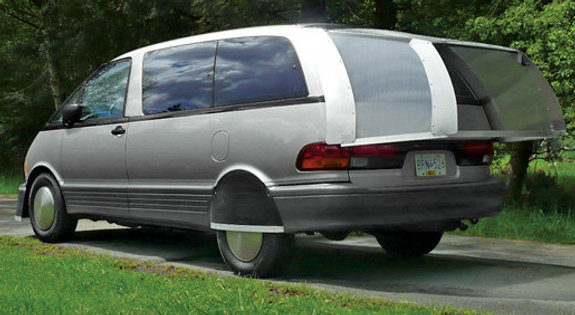
Do it yourself ecomodded Toyota Previa

Marcus Sabathil is a glass artist and furniture
maker who managed to modify
his Toyota Previa in such
a way to increase highway mileage from 20 to 36 mpg.
I've often wondered how much
of a gain we might get from our Toyota Previa if we fabricated a
similar boat tail.
Want more in-depth information? Browse through our books.
Or explore more posts by date or by subject.
About us: Anna Hess and Mark Hamilton spent over a decade living self-sufficiently in the mountains of Virginia before moving north to start over from scratch in the foothills of Ohio. They've experimented with permaculture, no-till gardening, trailersteading, home-based microbusinesses and much more, writing about their adventures in both blogs and books.
Want to be notified when new comments are posted on this page? Click on the RSS button after you add a comment to subscribe to the comment feed, or simply check the box beside "email replies to me" while writing your comment.

The drag from the rear end of a car comes mostly from the vortices that fill the relative void behind the car.
I'm thinking that a variant on base bleed would be easier to make because it wouldn't require you to extend the car body. Basically scoop up air from a high-pressure area at the front of the vehicle and channel it to the back, filling the low-pressure area. Probably an extra fan would be necessary to generate enough flow. Since my yearly bicycle mailage is higher than my car milage, I won't bother. But I'd be interested if someone tried it.
BTW, I love to see the Aerocycle that is mentioned in the linked article get some more attention internationally. I saw it a couple of years ago on a Dutch site, and I still think it looks way better than all those modified cars. On the same note, I think the zerotracer is a wicked cool bike!
That is a great idea Rolland!
I wonder if one of those new Dyson fans would be enough air flow?
I would think the fan would need some sort of advanced control to tweak it to the point where the air flow was equalizing it in a way to reduce drag?
Maybe a whole bank of smaller fans that had a control panel to turn some of them off when needed?
This idea deserves more attention.
To completely fill up the void, you'd have to punp in quite a lot of air. The same amount as strikes the front surface of the car, to be exact. So that's not going to happen.
What one would like to achieve is to release enough air so that the virtual "tail" of the car gets longer and you avoid the turbulence. This earodynamics page in the "steady separation" picture shows what I mean. The "turbulent wake" pictures show what normally happens. As to how much air you'd need for that I have no idea. One would have to test that.
Adding a top spoiler (see "Additional mods for Vans and SUVs") or a diffuser are two ways of helping to fill the void without having a lot of pipes running through your car.
Of course the easiest way to reduce drag is to slow down. Drag is proportional to the square of the speed, so slowing from 60 mph to 50 mph would reduce drag by (60²-50²)/60²·100% = 30%.